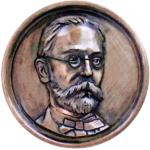W opracowaniu
Aktualny numer
Numery specjalne
Archiwum
O czasopiśmie
Redakcja
Rada Redakcyjna
Recenzenci
Instrukcja redakcyjna
Zasady etyki publikacyjnej
Zasady recenzowania
Ghostwriting
Prawa autorskie i polityka Open Access
Klauzula informacyjna RODO – dla autorów artykułów zgłoszonych do publikacji w kwartalniku „Komunikaty Mazursko-Warmińskie”
Kontakt
Cennik
PROJEKTY
Długie trwanie staropruskich struktur
plemiennych na przykładzie organizacji
parafialnej na Sambi
1
Instytut Historii
Uniwersytet Gdański
Data publikacji online: 23-11-2016
Data publikacji: 23-11-2016
KMW 2016;293(3):561-578
SŁOWA KLUCZOWE
DZIEDZINY
STRESZCZENIE
This paper seeks to present some tribal institutions that survived the conquest of Prussia by the Teutonic Knights as part of the parish structure in Sambia (Samland). This was the most populous tribal area in
pagan Prussia. After its conquest in 1255, the Knights decided to build the local parish network on the basis
of native territorial communities (so-called territoria). Thus, ultimately, the parish network in Sambia – with
the exception of a sparse towns – was connected with so-called Kammerämter set up since the end of the 13th
c. which, in turn, were based on the above territoria from the pagan period. In the early 15th c. there were 18
such local government units there managed by the Order or the local bishop. Parish churches were mostly built there in the seats of local clerks called Kämmereren. As a result, the parish network in the Bishopric of Sambia was relatively sparse. Pastoral work was also made difficult by that fact that most German parish priests did
not know Old Prussian and that there were often problems with completing parish staff. Right before the Teutonic conquest of Sambia there were 15 territoria there. They were characterised by a high degree of external
autonomy, but preserved loyalty towards the interests of the higher-order territorial community, i.e. the Sambian tribe. The political-territorial unit even smaller than the Prussian territorium was the moter (moter, muter, motor). It was probably a stronghold unit. There could be two or more such units in each territorium. The
moter can also be called a community of local groups, since it embraced 5-10 villages. Georg Gerullis pointed out that even as early as church acts from the mid-17th century (1652 or 1665) there are records of 4 moters (e.g. Suppliten Moter) in the Sambian parish of Pobethen (today’s Romanovo), each of which had a Kirchenvater, i.e. a representative of the parish community from whom it derived its name. In the opinion of Hans
and Gertrud Mortensens, what we deal with here are areas of a size similar to the medieval moters in Sambia.
What is more, the area of the Pobethen parish probably roughly corresponded to that of the former Kammeramt of Pobethen, and the earlier Pobeten or Bethen territorium mentioned under the year 1260 in the Teutonic chronicle of Peter of Dusburg. Reinhard Wenskus claimed that the name Suppliten Moter may be connected with the name of Valtin Supplit, who, according to Lucas David’s chronicle, was the chief official during
the ceremony of two pagan sacrifices that took place in the 1520s at Rantau (today’s Zaostrovye) in the parish
of Pobethen. In the opinion of this scholar, the 17th-century office of the moter Kirchenvater could be a continuation of the office of a pagan cult functionary, evidently associated with this old Prussian territorial unit.
In this paper this thesis has been corroborated. A hypothesis was also proposed that what could serve as a diffusion channel here was the institution of one- or a few-person representation of a village at mass, popular in
medieval Prussian dioceses. Using the Pobethen parish as an example, it was also shown that in the pagan times moters enjoyed a much wider ceremonial autonomy in the higher-order territoria than in the later official parish-Kammeramt structures.
Przetwarzamy dane osobowe zbierane podczas odwiedzania serwisu. Realizacja funkcji pozyskiwania informacji o użytkownikach i ich zachowaniu odbywa się poprzez dobrowolnie wprowadzone w formularzach informacje oraz zapisywanie w urządzeniach końcowych plików cookies (tzw. ciasteczka). Dane, w tym pliki cookies, wykorzystywane są w celu realizacji usług, zapewnienia wygodnego korzystania ze strony oraz w celu monitorowania ruchu zgodnie z Polityką prywatności. Dane są także zbierane i przetwarzane przez narzędzie Google Analytics (więcej).
Możesz zmienić ustawienia cookies w swojej przeglądarce. Ograniczenie stosowania plików cookies w konfiguracji przeglądarki może wpłynąć na niektóre funkcjonalności dostępne na stronie.
Możesz zmienić ustawienia cookies w swojej przeglądarce. Ograniczenie stosowania plików cookies w konfiguracji przeglądarki może wpłynąć na niektóre funkcjonalności dostępne na stronie.




